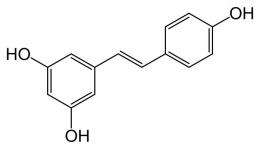June 23, 2011 report
Chemists figure out how to synthesize compounds from resveratrol

(PhysOrg.com) -- Researchers working at Columbia University in New York have succeeded in synthesizing several compounds from the stilbenoid, resveratrol, a chemical commonly found in the skin of grapes that has been shown to have a wide variety of medicinal benefits.
The team, led by Scott Snyder, devised a technique to get around the problem of individual plants making such minute quantities of the chemical that it has been virtually impossible until now to isolate and then put them to good use; they built compounds that are similar to the polyphenols normally produced by grapes, but different enough to allow the syntheses of differing chemicals contained within them.
The health benefits of resveratrol are wide and varied; some have suggested that it’s responsible for the relatively low levels of coronary disease in France, due to the resveratrol in red wine that is consumed widely in the country, this despite the fact that the French diet is known for inclusion of lots of fatty foods. Also, a recent study by a University of Florida team of researchers found evidence that resveratrol might make getting older a less traumatic experience.
Thus, the search to find ways to extract the chemical from grapes, or other resveratrol producing plants, so as to put it in a pill that people could take, has been underway for several years. Until now though, the going has been extremely slow due to the plants stubborn insistence on making just enough of the stuff to ward of diseases such as fungus.
Now however, Snyder and his colleagues Andreas Gollner and Maria Chiriac, have figured out a way to use a reagent (a chemical or substance added to something to produce a specific reaction) called bromodiethylsulfide bromopentachloroantimonate to cause a resveratrol dimer (a chemical structure consisting of two sub-units) to accept additional monomers (a molecule that binds to other molecules to form a polymer) to in effect, grow more resveratrol from its basic unit, allowing for the production of virtually any amount of the precious chemical.
Having resveratrol in pill form would offer the benefits of drinking red wine to consumers without the drawbacks, such as the ill effects of alcohol and the breakdown of tooth enamel that occurs with all citric based drinks that lead to dental problems.
More information: Regioselective reactions for programmable resveratrol oligomer synthesis, Nature 474, 461–466 (23 June 2011) doi:10.1038/nature10197
Abstract
Although much attention has been devoted to resveratrol, a unique polyphenol produced by plants and credited as potentially being responsible for the ‘French paradox’—the observation that French people have a relatively low incidence of coronary heart disease, even though their diet is high in saturated fats—the oligomers of resveratrol have been largely ignored despite their high biological activity. Challenges in achieving their isolation in sufficient quantity from natural sources, coupled with an inability to prepare them easily synthetically, are seen as the main obstacles. Here we report a programmable, controlled and potentially scalable synthesis of the resveratrol family via a three-stage design. The synthetic approach requires strategy- and reagent-guided chemical functionalizations to differentiate two distinct cores possessing multiple sites with the same or similar reactivity, ultimately leading to five higher-order natural products. This work demonstrates that challenging, positionally selective functionalizations of complex materials are possible where biosynthetic studies have indicated otherwise, it provides materials and tools with which to unlock the full biochemical potential of this family of natural products, and it affords an intellectual framework within which other oligomeric families could potentially be accessed.
© 2010 PhysOrg.com













